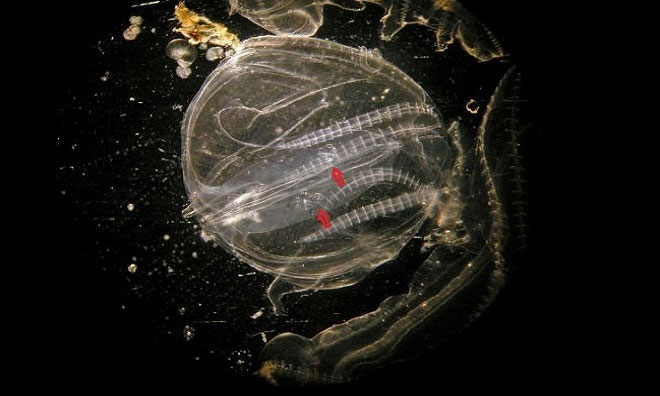Aggressive jellyfish eat offspring to survive
Thousands of invasive Leidyi jellyfish in the Baltic Sea began to eat offspring at the end of the summer in order to survive the food scarcity.
According to research published May 7 in the journal Communications Biology, cannibalism is just part of the lives of jellyfish living in nutrient-poor waters outside their natural habitat, helping them have the energy to survive for a few more weeks after slaughtering local prey populations.

Two young jellyfish in the bag lead food into the mouth of an adult jellyfish. (Photo: Live Science).
"In a way, the whole jellyfish population acts as a whole, in which the juvenile group provides food for the adult jellyfish to overcome the stresses of nutrient resources," said Thomas Larsen, co-author. Research at the Max Planck Institute of Human History in Jena, Germany, said. "This allows jellyfish to survive extreme events and food shortages, adapting to a variety of climatic systems and conditions."
In the new study, the authors tracked the population of the Leidyi jellyfish (Mnemiopsis leidyi) living in the Kiel Fjord, a long bay on the Baltic Sea near northeastern Germany. The comb is native to the western Atlantic Ocean near North America and South America, but introduced into the relatively cold Baltic Sea in the 1980s. This invasive species is facing a food shortage. much longer than its Atlantic counterpart. However, they still find a way to thrive.
The success of the jellyfish in the Baltic Sea is partly due to the reproductive cycle. In the late summer, jellyfish breed quickly, each jellyfish releasing hundreds of eggs and sperm into the water at the same time, causing the number to increase thousands of times. The army of larvae is ready to eat every prey they can find, mostly small zooplankton until there is nothing left. Not long after the local prey population collapsed, jellyfish larvae also starved to death.
While taking samples of the Baltic comb jellyfish population and their prey in August and September 2008, the team discovered an adult jellyfish with two juveniles in its pouch leading the food directly into its mouth. This is evidence that helps explain that adult jellyfish continues to grow for weeks after prey and larvae die. But to confirm cannibalistic behavior, researchers need to confirm that adult jellyfish takes nutrients from young animals.
In September 2016, the team raised adult jellyfish and larvae in the laboratory. Within 36 hours, the adult jellyfish ate any juveniles in the tank. Subsequent analysis showed that the carnivorous larvae accounted for about 4% of the total carbon and 2.5% of the total nitrogen in the body of each adult jellyfish, suggesting that they have a higher nutrient density than the same jellyfish group Only eat crustaceans. "We have found the first evidence that adult M. leidyi jellyfish eat their own larvae. Because the larvae cannot survive the winter in northern habitats, we speculate the main purpose. M. leidyi larvae store energy and nutrients for adults , " the researchers said.
- The mother lion eats her son: Why does the "Tiger do not eat me"?
- Why do their predators eat?
- 65 interesting things about jellyfish (1)
- The evolutionary secret helps jellyfish survive without the heart and brain
- Jellyfish species can 'knock down' American carriers
- 65 interesting things about jellyfish (2)
- Beautiful sparkling jellyfish kingdom
- Do you know how jellyfish burn us?
- Beauty of jellyfish in the dark
- Startled with the danger of jellyfish invading the oceans
- Jellyfish cannot 'invade' the planet
- The first purple jellyfish on the planet
- How does jellyfish dominate the sea when there is no brain?
- Video: Turned around a rare fried egg jellyfish
 Surprised: Fish that live in the dark ocean still see colors
Surprised: Fish that live in the dark ocean still see colors Japan suddenly caught the creature that caused the earthquake in the legend
Japan suddenly caught the creature that caused the earthquake in the legend A series of gray whale carcasses washed ashore on California's coast
A series of gray whale carcasses washed ashore on California's coast Compare the size of shark species in the world
Compare the size of shark species in the world Scene of more than 150 tons of jellyfish destroying a power plant in China
Scene of more than 150 tons of jellyfish destroying a power plant in China  Magical images never seen before in jellyfish
Magical images never seen before in jellyfish  Find out 'Frankenstein's monster' reassembled 2 body pieces to continue living
Find out 'Frankenstein's monster' reassembled 2 body pieces to continue living  Scientists decipher the secret of the immortal jellyfish's longevity
Scientists decipher the secret of the immortal jellyfish's longevity  How jellyfish stings and how to treat jellyfish stings
How jellyfish stings and how to treat jellyfish stings  Scientists have just discovered a way to read the mind of jellyfish, which have no brains
Scientists have just discovered a way to read the mind of jellyfish, which have no brains 